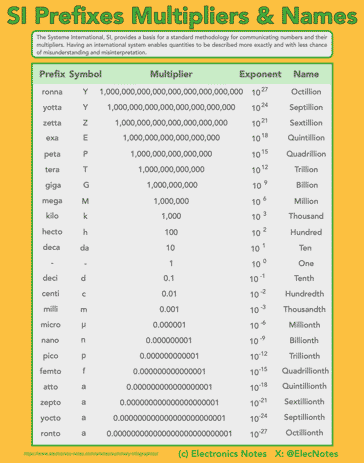SI Prefixes or Metric prefixes
The SI prefixes or metric prefixes are an indicator that precedes a basic unit of measure to indicate a multiple or sub-multiple of the unit.
SI, International System of Units Includes:
SI base units
SI units & symbols
SI / metric prefixes
Unit definitions
SI (metric) / Imperial conversion
Summary of common units for electronics
Often within electronics, and many other areas, quantities can become very large. To make these numbers easier to manage and comprehend, there is a system of prefixes used that indicates a multiple or submultiple of the quantity.
The multiples or submultiples are often called SI prefixes or metric prefixes because they precede the associated symbol to form a decimal multiple or sub-multiple.
These SI prefixes or metric prefixes are particularly useful and reduce the number of zeros required to define a given quantity, making it not only easier to read but also to manage and manipulate.
These SI prefixes or metric prefixes are in widespread use in all areas of life.
Table of SI prefixes
The factor expressed as a factor to the power of ten, SI / metric prefix, the symbol used and the actual decimal number are tabulated in the chart below.
In total there are twenty prefixes that have been officially adopted to be used with the various units of measure. They are widely used and are easy to add to the basic units.
| Table of SI / Metric Units, Symbols and Numbers |
|||
|---|---|---|---|
| Factor | Prefix | Symbol | Decimal |
| 1030 | quetta | Y | 1 000 000 000 000 000 000 000 000 000 000 |
| 1027 | ronna | R | 1 000 000 000 000 000 000 000 000 000 |
| 1024 | yotta | Y | 1 000 000 000 000 000 000 000 000 |
| 1021 | zetta | Z | 1 000 000 000 000 000 000 000 |
| 1018 | exa | E | 1 000 000 000 000 000 000 |
| 1015 | peta | P | 1 000 000 000 000 000 |
| 1012 | tera | T | 1 000 000 000 000 |
| 109 | giga | G | 1 000 000 000 |
| 106 | mega | M | 1 000 000 |
| 103 | kilo | k | 1 000 |
| 102 | hecto | h | 100 |
| 101 | deca | da | 10 |
| 10-1 | deci | d | 0.1 |
| 10-2 | centi | c | 0.01 |
| 10-3 | milli- | m | 0.001 |
| 10-6 | micro | µ | 0.000 001 |
| 10-9 | nano | n | 0.000 000 001 |
| 10-12 | pico | p | 0.000 000 000 001 |
| 10-15 | femto | f | 0.000 000 000 000 001 |
| 10-18 | atto | a | 0.000 000 000 000 000 001 |
| 10-21 | zepto | z | 0.000 000 000 000 000 000 001 |
| 10-24 | yocto | y | 0.000 000 000 000 000 000 000 001 |
| 10-27 | ronto | y | 0.000 000 000 000 000 000 000 000 001 |
| 10-30 | quecto | y | 0.000 000 000 000 000 000 000 000 000 001 |
Examples of SI prefixes
The SI prefixes/ metric prefixes are easily used as demonstrated by the few simple examples given below:
- 1 Megawatt = 1 000 000 watts
- 1 kilogram = 1000 grams
- 1 µF = 1 microFarad = 1 / 1 000 000 Farad
- etc ... etc ...
Along with these the abbreviations or symbols can also be used. For example kV for kilovolts; kW for kilowatts, and km for kilometre. The other symbols or abbreviations can be used in exactly the same manner. However it is necessary to ensure that the case of the letter is correct, i.e. lower case or uppercase. Many times frequencies of 10 mHz have been seen when what is really meant is 10 MHz.
SI prefixes are internationally recognized and have been in use for many years. In fact many of them pre-date SI itself and have been used since the metric system was first introduced - hence the name of metric prefixes that is often used for them. In addition to this many of these SI prefixes or metric prefixes are used with many non-SI units or even non-metric units: for example: milligauss (mG), microinch(µin), etc. . . .
SI prefixes infographic
It cna be very helpful to have an infographic that provides the various SI prefixes that are in common usage.
Understanding their names and the multiplication factors can be very useful when using the measurements that are commonly found in the electronics, radio, and connectivity technology, as well as in science in general.

Click on image for larger version
The SI prefixes or metric prefixes are particularly useful and are used almost without exception globally, providing an easy method of describing quantities in a succinct and manageable fashion.
 Written by Ian Poole .
Written by Ian Poole .
Experienced electronics engineer and author.
More Basic Electronics Concepts & Tutorials:
Voltage
Current
Power
Resistance
Capacitance
Inductance
Transformers
Decibel, dB
Kirchoff's Laws
Q, quality factor
RF noise
Waveforms
Return to Basic Electronics Concepts menu . . .



